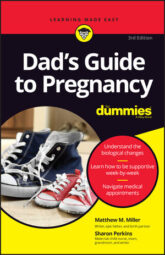Put down the twigs and leaves new dads— this isn't that kind of nesting. The nesting referred to is all about making the concept of baby a real thing in your everyday life.
Nesting can give you a sense of progress in the seemingly endless pregnancy and serves as the first of many acts of giving and loving that you'll show your baby. It can also be a great motivator for finally repainting the kitchen cabinets and replacing the broken bathroom tile.
Why make the house spick-and-span — and then some
For many pregnant women, the biological need to nest can be powerful. It can also veer into the seemingly irrational as your partner donates or trashes perfectly good linens, rugs, and towels because they may have unseen germs. Some women even get the urge to grab a toothbrush and some disinfectant and literally scrub the house top-to-bottom. This is perfectly normal — if mildly aggravating at times.
Try your best to be supportive without breaking the bank on unnecessary purchases. If your towels aren't in need of replacing, suggest having them professionally cleaned instead. Sometimes, however, the best thing to do when your pregnant partner is going through a bout of nesting-induced hysteria is to just let her do it. It's a natural process, and, as with all things, this too shall pass.
However, don't just sit back and watch. She may not ask, but she definitely wants you to help with the cleaning and organizing. Even if you don't think everything she's doing is necessary, she may be unable to see why it's not as important to you as it is to her.
Simply ask her how you can help or just join in with the express knowledge that this is a fleeting phase of late pregnancy.
This is also a time when your partner feels the need to launch a new set of rules regarding safety and cleanliness, such as no more shoes in the house or no more dogs allowed on the sofa. If your partner feels very strongly about something you disagree with, work together to find a compromise.
Pregnant women have to be a little more cautious than normal while doing work around the house. Take note of the following household projects and their do's and don'ts:
Cleaning: Using eco-friendly cleaning products is always better, so start during pregnancy. Your partner will avoid exposure to harsh chemicals, and you'll already be prepared for the day when baby is crawling around and putting everything in his mouth.
Lifting: It's a myth that lifting heavy objects lowers a baby's birth weight or causes birth defects. (Also, raising her hands over her head doesn't cause the baby to become tangled in the umbilical cord, although her mother — and yours! — may insist otherwise.)
But a woman's center of gravity changes as her stomach grows, and her tendons and ligaments soften. Lifting objects heavier than 25 pounds in the last few months of pregnancy can throw off your partner's balance and result in a fall, so have her leave the heavy lifting to you.
Painting: Pregnant women should avoid the urge to paint the nursery — or anything else, for that matter — because, among other potentially harmful chemicals, latex paint may contain mercury, and old paint can contain lead, both of which can cause harm. Sanding, which can release lead from old paint, is also a no-no.
As many as 75 percent of houses built before 1978 contain some lead paint. If your partner is going to be around while you coat the walls, make sure the room is well ventilated and that she consumes no food or beverages in the room where you're painting.
Pet care: According to the U.S. Centers for Disease Control and Prevention, pregnant women shouldn't clean a cat's litter box because of the risk of toxoplasmosis, a parasite in cat feces that can cause congenital defects in the baby. To further decrease the chance of toxoplasmosis, make sure you clean the litter box frequently, keep your cats indoors, and avoid adopting new cats during pregnancy.
Basics of Pinterest preparedness for Dads
Chances are your significant other has been "pinning" her favorite recipes, outfits, quotes, and home décor styles for years now. In fact, your whole future — from what next year's Thanksgiving centerpiece will look like to what kind of house you're going to live in ten years from now — very well could be planned out on the Internet.
Pinterest is a website where users create themed, virtual bulletin boards to which they pin the ideas and inspirations for things they'd like to buy, make, or do in the future. It's the perfect place to share likes, dislikes, styles, and dreams, which is why it's an ideal place to begin planning for baby's arrival.
Surprise your partner by creating a secret board that only the two of you can see, and begin searching for the things you want for your baby. Nurseries that speak to you, things for which to register, names, your favorite stroller, parenting inspirations — it's all there and more, and it will give you the chance to be an equal voice in the decision-making process.
Although Pinterest isn't the most popular Internet destination for men, being able to share what you like with each other and comment on each others' ideas in a safe online space often is easier and less stressful than spending hours and hours at store after store trying to make a decision together.
You'll learn a lot about each other, and knowing what your partner likes versus what you like ultimately makes compromise much simpler… and you may just avoid an argument or two.

